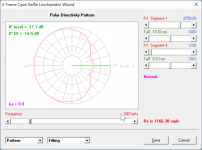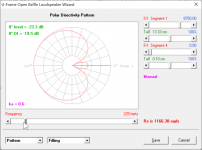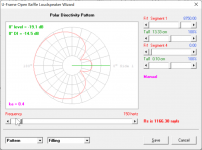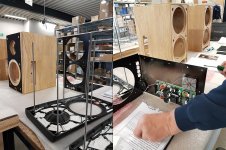Well not as close as I thought, but still Franconia! Send me a PM the next time you go shopping at the big 't', I'll invite you for coffee.
Separate enclosures seems the way to go then. Two TIW200XS per speaker, so 4 in total. You're aiming for 100dB @ 20Hz?
Separate enclosures seems the way to go then. Two TIW200XS per speaker, so 4 in total. You're aiming for 100dB @ 20Hz?
Is there a difference in damping/absorption between basotect and other brands of melamine foam?That is really good results squeeze86
Seem you have nailed the outlet material..... where do you purchase the 1 cm Basotect and is it "real" Basotect or a variant of open cell melamine?
You say you use a new waveguide ... which one?
Have you had any chance to listen to the difference in a room with the outlet/slots closed vs open?
I'm working a on a smaller PC speaker with 5" woofer and 1" dome with waveguide, and the intention was to try out either slots or going full in with side firing drivers to achieve CD down to say 200 Hz. I think just going waveguided for nearfield listening has been a learning. The sound is for sure different and more precise, but I think I'm giving up some of the airiness and room .... but having changed tweeter along the way makes this statement more uncertain, as I have observed a lot of difference in this change! All controlled with DSP and therefore same overall freq response.
Bass notes were a little less distinct, and transients like a kick drum, a little more 'rounded over' sounding.
Nothing majorly bad, but definitely audible. It was a fun demo setup 🙂
People should subscribe to "Speaker Freakers" over on Facebook. The prosound folks have a lot more experience with cardioid bass than we do. What you describe is something they lament; cardioid subs aren't "punchy."
The wall of my living room is absolutely ridiculous, measuring well over five meters tall, and something I've been toying with this afternoon is doing something similar to the Danley "Boundary Control" subs.
Basically use a baffle that's so large, the sound can't "leak" backwards.
About twenty years ago I had my stereo set up in a concrete bassment, and noticed the subs were unmistakably "punchier" and I think this was because concrete walls backed by infinite amounts of earth don't flex.
At a house I rented a few years ago, I made the mistake of putting one of the subwoofers in a closet near the living room. My assumption was that the bass would travel through the drywall. Instead, the bass notes made the entire house shake. I think the sound of the house shaking was more prominent than the subs themselves! (The wife did NOT love this set up.)
To Dave123: It's not easy to get the cardioid to work really well. There are a few DIY people and companies who have tried, but nobody seems to get results better than a wide-band rejection of approximately 10 dB relative to the front. That's what I got as well in my first few designs. I've since figured out a repeatable method to achieve between 15 and 20 dB. Inside I still feel like the DIY nerd I was ten years ago, and therefore I feel this urge to share all my 'secrets'. But my partners would be very angry with me if I did.
Some general pointers (some of which have been raised by others as well): the depth of the enclosure matters a lot; the kind of material has an influence (rockwool, fiberglass, polyester wool all work well); it generally helps to have the slots relatively close to the front baffle.
Here you'll find a photo of the inside of the 8c's cabinet: 6moons: audioreviews Dutch & Dutch 8c
The Olympus' cardioid works better than most I've seen, but only after I replaced the perforated back-panel with a solid panel: 2-way: Waveguide + Cardioid-like
If you feel the 8c doesn't play loud enough, I can highly recommend the 12" mid format with multi-sub!
Since I don't work for Dutch and Dutch and I'm just speculating here, let me take a crack at this one:
1) A plain ol' U-Frame can get you a cardioid response over a limited bandwidth. Not a lot - about 1-2 octaves.
2) According to the Stereophile review (https://www.stereophile.com/content/dutch-dutch-8c-active-loudspeaker-system-specifications) the midbass in the Dutch & Dutch 8C is playing from 100Hz to 1250Hz. So that's 3.5 octaves, much more than is possible with a plain ol' U-Frame
3) Pure speculation on my part, but I've tinkered around with baffle shapes and depths and found that you can use the baffle dimensions and depth can be used to manipulate the beamwidth of a driver mounted in a baffle. For instance, an 8" woofer has a cone that's about seven inches in diameter. 2000Hz is seven inches long. What this means, is that the baffle of the Dutch and Dutch 8C isn't large enough to constrain the radiation to 180 degrees. If the baffle was one meter in diameter, it would have no issue constraining 1khz into a beamwidth of 180 degrees. But because the baffle is much smaller than 34cm (the length of 1khz), what happens is that a fraction of the wavefront is directed forward AND a fraction of the wavefront diffracts around the enclosure itself. If you look at loudspeakers from folks like Kevin Voecks, he's VERY familiar with this phenomenon, and he's using the baffle shape to control directivity. I would also argue that the reason that the most expensive speakers from Voecks have a roundover and the midrange ones DO NOT is because Voecks understands that the enclosure shape is a big contributor to the sound. In a nutshell, if the inexpensive speakers from Revel had a carefully crafted baffle like the Revel Salon, then Revel might not sell many of their top-of-the-line speakers, because the mid-range speakers would be much more compelling. It's one of these situations where spending an extra $20 on the baffle would make a far greater contribution than a fancy capacitor or inductor, but Revel won't do it to preserve sales at the high end. See: https://www.diyaudio.com/community/threads/the-preference-for-direct-radiators.330741/
4) YMMV, but I think the key to figuring out how the Dutch & Dutch 8C achieves such a wide bandwidth from the midbass, is to look at how the woofer in the back of the box interacts with the woofer in the front of the box. In particular, the group delay on a low pass filter has the effect of virtually moving a woofer away from you. For instance, if you put a low pass 2nd order filter on a woofer, the low pass introduces something like five milliseconds of delay. Sound travels 34cm in a millisecond. Which means that the low pass filter has the effect of virtually moving the woofer 1.7 meters BEHIND the loudspeaker enclosure. Now if you read that, you might think "Bateman that makes no sense, because the woofer is ALREADY behind the midbass." The "trick" here, is that you tweak the crossover slope and the distance from front to back, and by juggling the variables you can get things configured so that the woofer in the back of the enclosure is a full 360 degrees out of phase (electrically) even if it's only physically a fraction of a wavelength behind the midbass. With some experimentation, you can even overlap the response between the front midbass and the rear woofer, so that both of them are covering the same frequencies. It might look a lot like a Gradient Subwoofer Array : https://www.merlijnvanveen.nl/en/calculators/28-sad-subwoofer-array-designer-en (is "Gradient" speakers named after this?) I know this is a complex topic and I've spent way too much time pondering it. When you hear people talk about how cardioids "aren't punchy" it might have something to do with this. If you have a typical dance song playing at 140 beats per minute, that's 2.33 beats per second. If your woofer is a full 360 degrees out of phase with the midbass, it will still measure flat (because it's in phase) but it will be delayed by a fraction of a second. Whether this is audible is a raging debate, and opens the can of worms of whether phase response is audible.
Last edited:
I think the more likely reason is that it actually costs much more than $20. Also interesting that the 328Be is now the flagship and has a much less complicated baffle/cabinet than the Salon 2 did.I would also argue that the reason that the most expensive speakers from Voecks have a roundover and the midrange ones DO NOT is because Voecks understands that the enclosure shape is a big contributor to the sound. In a nutshell, if the inexpensive speakers from Revel had a carefully crafted baffle like the Revel Salon, then Revel might not sell many of their top-of-the-line speakers, because the mid-range speakers would be much more compelling. It's one of these situations where spending an extra $20 on the baffle would make a far greater contribution than a fancy capacitor or inductor, but Revel won't do it to preserve sales at the high end.
The theoretical basis for making it happen is very simple, you can mimic the circumstances in simulation with an active source. In an active version you need a delay and low pass filter, these can be the same filter as long as the low pass filter has the right delay to match the time of flight from the front source to the side source with diffraction accounted for. That will give a pretty good range of cardioid behaviour. If you vary the position of the side source it will change the range of frequencies where the cardioid action can happen. The passive cardioid has to do the same, position the side vent in the right place and choose the right internal enclosure and absorption to create the right amount of delay and low pass filtering. The complicated part is experimenting or simulating to find out what you need to do to get the response you want.4) YMMV, but I think the key to figuring out how the Dutch & Dutch 8C achieves such a wide bandwidth from the midbass, is to look at how the woofer in the back of the box interacts with the woofer in the front of the box. In particular, the group delay on a low pass filter has the effect of virtually moving a woofer away from you.
Cardioid and Dipoles are both First Order Gradient Sources so it would make sense.(is "Gradient" speakers named after this?)
Phase change at low frequencies is much more audible than it is at high higher frequencies, a quick test with an FIR filter is easy to hear.Whether this is audible is a raging debate, and opens the can of worms of whether phase response is audible.
Thanks for the "Speaker Freakers" tip. I've seen it mentioned a few times, but kinda avoid facebook as a rule. Maybe time to check it out.People should subscribe to "Speaker Freakers" over on Facebook. The prosound folks have a lot more experience with cardioid bass than we do. What you describe is something they lament; cardioid subs aren't "punchy."
The wall of my living room is absolutely ridiculous, measuring well over five meters tall, and something I've been toying with this afternoon is doing something similar to the Danley "Boundary Control" subs.
Basically use a baffle that's so large, the sound can't "leak" backwards.
About twenty years ago I had my stereo set up in a concrete bassment, and noticed the subs were unmistakably "punchier" and I think this was because concrete walls backed by infinite amounts of earth don't flex.
At a house I rented a few years ago, I made the mistake of putting one of the subwoofers in a closet near the living room. My assumption was that the bass would travel through the drywall. Instead, the bass notes made the entire house shake. I think the sound of the house shaking was more prominent than the subs themselves! (The wife did NOT love this set up.)
I have a high ceiling too, but in my room bass doesn't seen to be a problem. The HF energy seems hardest to tame.
Big yes! , on concrete basements reinforcing subs. I think they are perfect for electrostats and other beautiful sounding, but weak-in-the-bass speakers.
And last, yeah crazy how bass works throughout a house. I run a metric shite ton of bass in my main room, but a 1/2 bath way off to the side has bass way stronger than in the main room...some kind of Helmholtz resonator i think.
I thought I'd come up with a way to improve the smoothness of transmission lines AND make them cardioid, but I only nailed the first part.
So if anyone wants a smooth TL, check this out: https://www.diyaudio.com/community/threads/an-improved-transmission-alignment-ii.391041/post-7142550
But it didn't offer the cardioid behavior I'd hoped for, so I'm going to continue down the U-Frame path
So if anyone wants a smooth TL, check this out: https://www.diyaudio.com/community/threads/an-improved-transmission-alignment-ii.391041/post-7142550
But it didn't offer the cardioid behavior I'd hoped for, so I'm going to continue down the U-Frame path
I did a sim using an MCM 55-3870, with the intention of approximating what's going on in the cardioid section of a Dutch & Dutch 8C:

This shows the output from the front, from the back, and the phase.
Yowza this is really nicely behaved.
I'm actually kinda shocked that everyone is on The Dipole Train when these u-frames behave so nice.
In an active gradient cardioid subwoofer array, you'd have two elements separated by one quarter wavelength at the center of their bandwidth. For instance, if they were intended to cover 100hz-400Hz, the front-to-back separation would be 42.5cm. (200hz is 170cm long.)
This passive cardioid accomplishes the same thing using a combination of the time delay that's introduced by the acoustic low pass filter that's caused by the rockwool, along with physically moving the vents behind the loudspeaker. Neat!

At 150Hz there's 13dB of rejection to the back

At 225hz there's 10dB of rejection to the back

At 300Hz there's 8dB of rejection to the back
If anything, it looks like I could get away with about half as much filling in the U-Frame

This shows the output from the front, from the back, and the phase.
Yowza this is really nicely behaved.
I'm actually kinda shocked that everyone is on The Dipole Train when these u-frames behave so nice.
In an active gradient cardioid subwoofer array, you'd have two elements separated by one quarter wavelength at the center of their bandwidth. For instance, if they were intended to cover 100hz-400Hz, the front-to-back separation would be 42.5cm. (200hz is 170cm long.)
This passive cardioid accomplishes the same thing using a combination of the time delay that's introduced by the acoustic low pass filter that's caused by the rockwool, along with physically moving the vents behind the loudspeaker. Neat!

At 150Hz there's 13dB of rejection to the back

At 225hz there's 10dB of rejection to the back

At 300Hz there's 8dB of rejection to the back
If anything, it looks like I could get away with about half as much filling in the U-Frame
I reran the sims from post 430, this time with half as much rockwool. That decreased output to the back of the enclosure by about double. (See attached.)
Here's some data on rockwool absorption: https://www.diyaudio.com/community/...l-low-distortion-with-a-2-way.334757/page-309
"RockBoard® 40 & FabRock™ LT would have similar air flow resistivity to the AFB® product [~15,000 – 20,000 mks rayls/m]
Here's some data on rockwool absorption: https://www.diyaudio.com/community/...l-low-distortion-with-a-2-way.334757/page-309
"RockBoard® 40 & FabRock™ LT would have similar air flow resistivity to the AFB® product [~15,000 – 20,000 mks rayls/m]
- RockBoard® 60 will have an expected air flow resistivity of ~32,000 – 46,000 mks rayls/m
- RockBoard® 80 is expected to have an air flow resistivity of ~53,000 – 57,000 mks rayls/m – also Comfortboard™80"
Attachments
There's some hints from Dutch & Dutch, in regards to optimizing these cardioids:
https://www.diyaudio.com/community/threads/2-way-waveguide-cardioid-like.192737/post-3887382
"The resistance enclosure works very well, but it requires a lot of experimentation with locations of the openings and damping material to get optimal results. The heavier, thicker fibreglass panels tend to work well, although it might pose a health hazard. This thread describes my first experiment with a resistance enclosure. Much better results are possible than shown here. A box with openings to the side but none in the back works well even when placed very close to the wall behind it.
A damped U-frame works better at lower frequencies, but as has been said above the exact amount and kind of damping material have a great effect on how well it will work. It requires some room behind the box to work well.
A cardioid composed of a combination of a dipole and a monopole should work fine. You have to equalize both to the same response, because otherwise their phase-relationship will not be the same. I think it should be possible to place this configuration quite close to the wall behind it, because the cancelling sources are in the same vertical plane and cancellation starts right there at the sources - not at some distance behind it, as is the case with a U-frame and a cardioid that consists of two monopoles.
A configuration with two monopoles in line can work very well too. You place one sub behind the other, you invert the phase of the rear sub and add a delay that corresponds with the propagation delay of the sound over that distance. This should work well up to about the frequency where the distance between the subs is about a quarter wavelength.
Last year I started a speaker company with two other guys and our speakers incorporate the resistance-box principle. We have been working hard developing our products and now they're almost finished."
https://www.diyaudio.com/community/threads/2-way-waveguide-cardioid-like.192737/post-3887382
"The resistance enclosure works very well, but it requires a lot of experimentation with locations of the openings and damping material to get optimal results. The heavier, thicker fibreglass panels tend to work well, although it might pose a health hazard. This thread describes my first experiment with a resistance enclosure. Much better results are possible than shown here. A box with openings to the side but none in the back works well even when placed very close to the wall behind it.
A damped U-frame works better at lower frequencies, but as has been said above the exact amount and kind of damping material have a great effect on how well it will work. It requires some room behind the box to work well.
A cardioid composed of a combination of a dipole and a monopole should work fine. You have to equalize both to the same response, because otherwise their phase-relationship will not be the same. I think it should be possible to place this configuration quite close to the wall behind it, because the cancelling sources are in the same vertical plane and cancellation starts right there at the sources - not at some distance behind it, as is the case with a U-frame and a cardioid that consists of two monopoles.
A configuration with two monopoles in line can work very well too. You place one sub behind the other, you invert the phase of the rear sub and add a delay that corresponds with the propagation delay of the sound over that distance. This should work well up to about the frequency where the distance between the subs is about a quarter wavelength.
Last year I started a speaker company with two other guys and our speakers incorporate the resistance-box principle. We have been working hard developing our products and now they're almost finished."
The loudspeaker that got this ball rolling had a gigantic enclosure that looks like swiss cheese, but the Dutch & Dutch 8C has a midbass enclosure that's dramatically smaller, with two well defined vents.
Why is that?

Here's a sim of a "conventional" U-Frame, where the area of the enclosure is constant. The area and length is based on my guesstimates of the midbass enclosure in the Dutch & Dutch 8C.
Overlaid over that, is the exact same enclosure - BUT I've reduced the size of the exit by 90%
We see that does a bunch of useful things.
First, it reduces output from the vent by about 6dB above 300Hz.

This is really useful, because if you look at the phase response of the "conventional" U-Frame, in the octave between 300-600hz, the output from the back of the woofer and the front of the woofer are beginning to be in-phase. We don't want this, this is very bad. If the output of the front and the back are in phase, you will not only lose the cardioid pattern that we're chasing after, you will ALSO have a situation where the speaker is louder OFF axis than ON axis. Imagine how useless a speaker would be if it was +6dB off-axis.
I created the graph above by simulating the output of a u-frame, then snapped a pic of the output from the woofer, and the output from the port. Then overlaid them in an illustration program. (I can't see any way to compare the two in Hornresp.)
The reason we don't want the enclosure to look like swiss cheese is because when the vents are all over the place, the delay of every single hole will be different. Not good; we don't want the output from a hole on the side to be 90 degrees out of phase with a hole in the back of the box.
I would include polars, but it's not possible to simulate polars in Hornresp with a tline.
Why is that?

Here's a sim of a "conventional" U-Frame, where the area of the enclosure is constant. The area and length is based on my guesstimates of the midbass enclosure in the Dutch & Dutch 8C.
Overlaid over that, is the exact same enclosure - BUT I've reduced the size of the exit by 90%
We see that does a bunch of useful things.
First, it reduces output from the vent by about 6dB above 300Hz.

This is really useful, because if you look at the phase response of the "conventional" U-Frame, in the octave between 300-600hz, the output from the back of the woofer and the front of the woofer are beginning to be in-phase. We don't want this, this is very bad. If the output of the front and the back are in phase, you will not only lose the cardioid pattern that we're chasing after, you will ALSO have a situation where the speaker is louder OFF axis than ON axis. Imagine how useless a speaker would be if it was +6dB off-axis.
I created the graph above by simulating the output of a u-frame, then snapped a pic of the output from the woofer, and the output from the port. Then overlaid them in an illustration program. (I can't see any way to compare the two in Hornresp.)
The reason we don't want the enclosure to look like swiss cheese is because when the vents are all over the place, the delay of every single hole will be different. Not good; we don't want the output from a hole on the side to be 90 degrees out of phase with a hole in the back of the box.
I would include polars, but it's not possible to simulate polars in Hornresp with a tline.
Attachments
@Patrick Bateman
A cardioid behaves kinda like a dipole for the lower frequencies.
The thing is, here we have combine the hornresp simulations you did with the damping material in combination with the bafflestep response. However, bafflestep behavior is kind of tricky to predict.
The slits are right next to the woofer, so there isn't much of the u-frame left actually.
U-frames also do have some disadvantages, if you dive deep into the caves of DIY research, there can be a lot of information found about this 😉
About different delays.
I doubt what you're saying is true, since at the piston region of a woofer (aka, the control system or lumped equivalent region) it's basically just one big pressure wave.
Technically "slits" all around would perform better (in theory) than just on the sides.
But I guess some compromises had to be made for aesthetics and practicality as well obviously 😉
So technically there isn't anything wrong with the swiss cheese design.
In fact, I have seen measurements that showed pretty nice cardioid behavior.
In these old topics, most of the answers can also be found btw.
the best way to simulate this would probably be Akabak btw.
fyi, I personally would never use this design below say 150Hz or zo, because at the point room modes will make a big mess of everything anyway. With a symmetrical subwoofer setup, one can also cross much higher in general.
A cardioid behaves kinda like a dipole for the lower frequencies.
The thing is, here we have combine the hornresp simulations you did with the damping material in combination with the bafflestep response. However, bafflestep behavior is kind of tricky to predict.
The slits are right next to the woofer, so there isn't much of the u-frame left actually.
U-frames also do have some disadvantages, if you dive deep into the caves of DIY research, there can be a lot of information found about this 😉
About different delays.
I doubt what you're saying is true, since at the piston region of a woofer (aka, the control system or lumped equivalent region) it's basically just one big pressure wave.
Technically "slits" all around would perform better (in theory) than just on the sides.
But I guess some compromises had to be made for aesthetics and practicality as well obviously 😉
So technically there isn't anything wrong with the swiss cheese design.
In fact, I have seen measurements that showed pretty nice cardioid behavior.
In these old topics, most of the answers can also be found btw.
the best way to simulate this would probably be Akabak btw.
fyi, I personally would never use this design below say 150Hz or zo, because at the point room modes will make a big mess of everything anyway. With a symmetrical subwoofer setup, one can also cross much higher in general.
Last edited:
My latest version with 8" waveguide from soma sonus for Bliesma T34B. I removed the flat outer edge of the WG to reduce the diameter with 20mm so it would fit the baffle. I am using a seas h-1212 tweeter. I had to use REW to measure because I am using roon with convolver. Gate is 4,5mS. It also starts to sound quite good. The image is deep with good placement of the performers with the speaker close to the front wall. That was important for my use of these speakers.
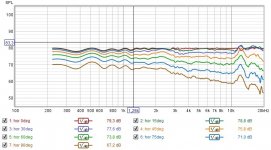
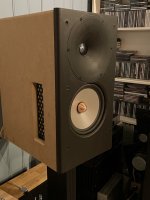


Nice speaker!
When you use convolutionfilters with Roon, how do you measure using REW including the convolutionfilter?
When you use convolutionfilters with Roon, how do you measure using REW including the convolutionfilter?
Thanks!Nice speaker!
When you use convolutionfilters with Roon, how do you measure using REW including the convolutionfilter?
There is a guide on the roon site, but it is basically to generate a logsweep in rew and save it as a wav file. Then you just upload this file to your music library and playback through roon/convolver while rew is recording the output.
Actually REW cannot record, you need to use some other recording software and import recorded sweep to REW.
https://www.roomeqwizard.com/help/help_en-GB/html/offlinemeasurements.html
https://www.roomeqwizard.com/help/help_en-GB/html/offlinemeasurements.html
I use the File Playback method with REW, works really well
https://www.roomeqwizard.com/help/help_en-GB/html/makingmeasurements.html#fileplayback
https://www.roomeqwizard.com/help/help_en-GB/html/makingmeasurements.html#fileplayback
It looks like you kept the grill attached to the tweeter. Is this correct? Assuming so, how did you modify the waveguide to accommodate the grill?My latest version with 8" waveguide from soma sonus for Bliesma T34B. I removed the flat outer edge of the WG to reduce the diameter with 20mm so it would fit the baffle. I am using a seas h-1212 tweeter. I had to use REW to measure because I am using roon with convolver. Gate is 4,5mS. It also starts to sound quite good. The image is deep with good placement of the performers with the speaker close to the front wall. That was important for my use of these speakers.
View attachment 1110886View attachment 1110885
- Home
- Loudspeakers
- Multi-Way
- Resistive port cardioid active speaker insipired by D&D 8C
